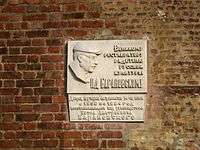Pyotr Baranovsky
Pyotr Dmitrievich Baranovsky (Russian: Пётр Дмитриевич Барановский; February 26, 1892 – June 12, 1984) was a Russian architect, preservationist and restorator who reconstructed many ancient buildings in the Soviet Union. He is credited with saving Saint Basil's Cathedral from destruction in the early 1930s, founding and managing the Kolomenskoye and Andrei Rublev museums, and developing modern restoration technologies.
Pyotr Dmitrievich Baranovsky | |
|---|---|
| Born | February 26, 1892 |
| Died | June 12, 1984 Moscow, Russian SFSR, Soviet Union |
| Nationality | Russian |
| Occupation | Architect |
| Buildings | Restoration of Krutitsy and St. Andronik Monastery |
| Projects | Kolomenskoye and Andrei Rublev museums |
Biography
Education and early career
Petr Baranovsky was born in a peasant family in Shuyskoye, Smolensk region, and completed a construction engineer's degree in Moscow in 1912, earning the medal of Russian Archeological Society for restoration of Boldino Trinity Monastery in his native Smolensk region. After a brief work on industrial and railway projects, with the outbreak of World War I, he was drafted into military engineers' corps. In 1918, he completed a second degree, in art studies, and joined the faculty of Moscow State University.
In 1921, Baranovsky settled for the first of his ten expeditions to the Russian North. In the course of his life he surveyed and recorded hundreds of architectural landmarks ranging from White Sea to Ukraine and Azerbaijan. In late 1920s, in the middle of anti-religious campaigns, he restored Saint Basil's Cathedral in Red Square, clearing the medieval landmark from alterations of later centuries.
Kolomenskoye
In 1924, Baranovsky persuaded the authorities to declare Kolomenskoye park a museum area, and became its first manager. From 1927 to 1934, he acquired and preserved wooden architecture from the Russian countryside, notably the House of Peter I which he brought from Arkhangelsk, the fortress tower of Sumskoy Ostrog on the White Sea, the Honey-Mead Brewery from Preobrazhenskoye, and others. Baranovsky personally surveyed, recorded and restored the local architecture of Kolomenskoye. In one case, he carefully demolished 19th-century alterations to the Church of Saint George in order to open access to the 16th century belltower. Today, the tower and refectory still stand separately.
Boldino museum and persecution
This section is based on materials of 2002 Baranovsky exhibition at the Moscow Museum of Architecture, collected by Maria Rogozina and Ulyana Chornovil
The only way to defend religious buildings in Soviet Russia was to convert them into museums. In 1923, Baranovsky succeeded in declaring Boldinsky Monastery a branch of Dorogobuzh Museum. He and two local museum managers collected relics from other temples that were looted by Bolsheviks, and preserved the collection of Yelnya museum that was closed in 1926. Baranovsky realized the uncertainty of his museum, and hired photographer Mikhail Pogodin, grandson of Mikhail Pogodin, to document Boldino and its exhibits (1928–1929). Baranovsky-Pogodin archives present a particular branch of Orthodox art of Upper Dnieper, the boundary between Orthodox and Catholic worlds.
In November 1929, authorities shut down the museum; its treasures are presumed lost, as is most of Pogodin's photography. In January 1930, they arrested Semyon Buzanov, the museum manager, who died in prison. Nikolai Savin, manager of Dorogobuzh museum, chose to flee his hometown; Pogodin lost his job as a "social alien". Baranovsky himself received a formal reprimand in 1931 but was arrested later, in 1934, accused of Anti-Soviet propaganda, and sentenced to an exile in Mariinsk, where he earned a "Siberian Camp Udarnik" badge.
Upon his return from Siberia, Baranovsky was subjected to 101st kilometre penalty rule, and had to commute to Moscow from Alexandrov. He witnessed and recorded the destruction of Kazan Cathedral in Red Square. It was reconstructed in 1990-93 using the sketches that Baranovsky made in the 1920s.
Andrei Rublev museum
After exile, in late 1930s, Baranovsky declared that he had found the grave of Andrei Rublev in St. Andronik Monastery, Moscow. The tomb was soon lost in another round of demolition; historians dispute the identity of Baranovsky's discovery, but it proved to be a solid argument for converting the monastery to museum of old Russian art. Baranovsky and Igor Grabar spoke for this museum and obtained the state decree for its opening in 1947, although it opened to general public only in 1960. The monastery was returned to the Church in 1989, the museum and restoration workshop operates to date.

Other post-war projects
During World War II, Baranovsky was employed by the State Commission for investigating fascist crimes in former occupied territories, later holding an official title in State Commission on preservation of monuments. He is credited with restoring the damages in Smolensk, Vyazma and other war losses.
For more than 30 post-war years, he headed restoration of Krutitsy monastery in Moscow, engaged in various other restoration projects and consultancies. He returned to Boldino in 1963, supervising restoration headed by his student, Andrey Ponomaryov.
Baranovsky died at the age of 92 and was buried inside Donskoy Monastery in Moscow.
References
- Russian biography: Бычков, Ю.А., "Житие Петра Барановского", М., Советская Россия, 1991
- Russian collection of selected works: Петр Барановский, "Труды, воспоминания современников", Сост. Ю. А. Бычков, О.П. Барановская, В.А. Десятников, А.М. Пономарев, М., 1996
- Moscow Museum of Architecture: 2002 Baranovsky exhibition, official site
- Kolomenskoye museum architecture,official site
- Kolomenskoye museum architecture, best unofficial site
- Andrei Rublev museum